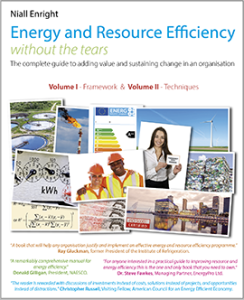[amazon_image id=”0954452933″ link=”true” target=”_blank” size=”medium” container=”div” container_style=”float:left; padding-right:10px;” ]Sustainable Energy – Without the Hot Air[/amazon_image] What can I say that has not already been said about David MacKay’ outstanding book on Sustainable Energy? It won plaudits from a wide range of reviewers (from the right and the left, from greens and cynics) and became one of the hottest selling non-fiction titles ever on Amazon.
So why all the hype about a book which essentially takes all the major sources of energy and piece-by-piece examines their current impact and potential future contribution to a low carbon world?
The reason for its outstanding success lies in MacKay’s ability to demystify the subjects he tackles. He starts with an energy “balance sheet” with two columns – on the left our daily consumption and on the right the daily production of energy, per person. All uses and sources of energy are converted to a constant kWh/day so we learn, for example, that the typical car driver uses 40 kWh/d while lighting is around one tenth this value at 4 kWh/d. Everything is comparable – so that the UK wind production at 20 kWh/day is less than half the energy used by cars. Excellent!
The very first section of the book is captioned “Numbers not Adjectives”, and this very much reflects the tone of the book. Although it is clearly on the side of the good in terms of our need to reduce carbon emissions it is not a polemic: it doesn’t appeal to fear, but to reason and logic. Therein lies its credibility – every number and calculation is explained. If, like me, you are a “back of a fag packet” order-of-magnitude quasi-engineer, then you will absolutely love this book! The numbers he present debunk some strongly-held myths such as the real impact of leaving chargers for our phones plugged in: at an average of 0.5 W the energy saved in a day by switching off the charger is less than that used in driving for just one second! As he puts it “its like bailing the Titanic with a teaspoon!”. I will finally be able to live with the guilt I feel when I see my chargers left plugged in!
Throughout the tone of the book is conversational, questioning, down-to-earth and thoroughly enthusiastic. The reader is following in MacKay’s footsteps like a fellow explorer, learning the truth about whether it makes sense to switch lights of or not, or just how much biomass we would need to replace gas power stations. Ample full-colour pictures, charts, tables and references testify to the care and attention put into the book and help bring each topic to life.
Having established our current daily production and consumption of energy, in Part 2 “Making a Difference” MacKay explores how and if we can transform ourselves into a low-carbon society. It is these chapters where folks coming from a particular perspective may have reason to question the analysis – for example the chapter on nuclear power confronts a number of myths that critics hold dear. Engineering friends have had cause to question the optimistic assumptions around the performance of heat-pump technologies. Although one may legitimately quibble about the relative merits of this or that technology, the numbers are all set out for us to examine and to think about. And thinking is the order of the day – MacKay sets out a number of alternative UK energy scenarios for 2050, with and without nuclear, and asks us to think about which are most realistic. Ultimately it is up to us to decide – we are not being sold a package but information and facts to enable us to draw our own conclusions.
For those who want to get deeper into the calculations – after all David MacKay is a Professor of Physics at Cambridge University – the Technical Chapters in Part 3 are a treasure trove. I am not sure how useful the equations for the air resistance of an airship will be in my own day-to-day work, but it is somewhat comforting to know that they are there and that MacKay understand them! On the other hand, the technical chapter on Heating, illustrated with examples from his own home, was particularly interesting.
Overseas readers should note that this is a very British book. All the data and examples relate to the UK (with the exception of a brief detour to discuss desert solar energy in North Africa). However the insights and learning provided are much more widely applicable.
I can thoroughly recommend this book. Since I first read it in 2009, it has been pulled out from by bookcase on many occasions when I have needed to remind myself of some fundamental aspects about energy energy use or generation. It is not the kind of reference book that one would use to evaluate a specific technology (there are other much more relevant titles for this) but rather a resource to see the forest as a whole – to understand the basics of a topic or a technology.
David MacKay and his publishers, UIT, are to be applauded for making the entire book available free of charge from his web-site. The whole book can be downloaded as a single 12MB pdf file or individual pages browsed in excellent web-page rendering of the originals. Some or all of the book can be found in translation at this site as well. If you become hooked on SEWTHA (as aficionados call it) then a paperback version is very modestly priced given that it runs to 350 pages in full colour.
By way of a postscript to this story: shortly after publication of SEWTHA , David MacKay was appointed Chief Scientific Adviser to the UK Department of Energy and Climate Change.
[easyreview title=”IMHO: Sustainable Energy Without the Hot Air” cat1title=”Usefulness” cat1detail=”Fantastic insights into all aspects of energy use and generation. Strong on theory but requires interpretation to apply to real-world projects. Very credible and authoritative analysis.” cat1rating=”3.5″ cat2title=”Relevance” cat2detail=”Covers the whole range of energy production and consumption. Ideas are widely applicable. Somewhat of a UK focus though.” cat2rating=”3″ cat3title=”Accessibility” cat3detail=”Hugely readable with technical detail phased in slowly.” cat3rating=”5″ cat4title=”Value for money” cat4detail=”Can’t get better than free! Even paid-for versions are very cheap.” cat4rating=”5″ summary=”A milestone in communicating energy issues. Highly recommended.”]
| [amazon_enhanced asin=”0954452933″ /] | KEY Usefulness: how will this book support a resource efficiency practitioner? Does the book give real-world examples and tools? Are reference to other sources of information well documented. Is it an objective and credible source? Relevance: how widely applicable is this book in delivering practical resource efficiency? Is it only for a narrow niche or are the concepts widely applicable? Are there good, contemporary examples of best practice? Accessibility: how well written and structured is the book? Is there an assumption about prior knowledge? Value for money: Taking into account the other parameters is this book a good investment? Overall: The average of the previous ratings. IMHO= in my humble opinion. Please post a response to the review if you feel I have got this wrong! |



0 Comments